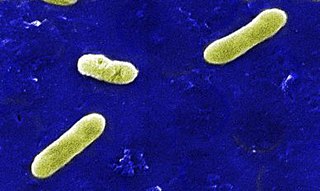
Respiratory syncytial virus (RSV), also called human respiratory syncytial virus (hRSV) and human orthopneumovirus, is a common, contagious virus that causes infections of the respiratory tract. It is a negative-sense, single-stranded RNA virus. Its name is derived from the large cells known as syncytia that form when infected cells fuse.

An upper respiratory tract infection (URTI) is an illness caused by an acute infection, which involves the upper respiratory tract, including the nose, sinuses, pharynx, larynx or trachea. This commonly includes nasal obstruction, sore throat, tonsillitis, pharyngitis, laryngitis, sinusitis, otitis media, and the common cold. Most infections are viral in nature, and in other instances, the cause is bacterial. URTIs can also be fungal or helminthic in origin, but these are less common.

Lower respiratory tract infection (LRTI) is a term often used as a synonym for pneumonia but can also be applied to other types of infection including lung abscess and acute bronchitis. Symptoms include shortness of breath, weakness, fever, coughing and fatigue. A routine chest X-ray is not always necessary for people who have symptoms of a lower respiratory tract infection.

Kennel cough is an upper respiratory infection affecting dogs. There are multiple causative agents, the most common being the bacterium Bordetella bronchiseptica, followed by canine parainfluenza virus, and to a lesser extent canine coronavirus. It is highly contagious; however, adult dogs may display immunity to reinfection even under constant exposure. Kennel cough is so named because the infection can spread quickly among dogs in the close quarters of a kennel or animal shelter.

Respiratory tract infections (RTIs) are infectious diseases involving the respiratory tract. An infection of this type usually is further classified as an upper respiratory tract infection or a lower respiratory tract infection. Lower respiratory infections, such as pneumonia, tend to be far more severe than upper respiratory infections, such as the common cold.
Aujeszky's disease, usually called pseudorabies in the United States, is a viral disease in swine that is endemic in most parts of the world. It is caused by Suid herpesvirus 1 (SuHV-1). Aujeszky's disease is considered to be the most economically important viral disease of swine in areas where classical swine fever has been eradicated. Other mammals, such as cattle, sheep, goats, cats, dogs, and raccoons, are also susceptible. The disease is usually fatal in these animal species.

Feline viral rhinotracheitis (FVR) is an upper respiratory or pulmonary infection of cats caused by Felid alphaherpesvirus 1 (FeHV-1), of the family Herpesviridae. It is also commonly referred to as feline influenza, feline coryza, and feline pneumonia but, as these terms describe other very distinct collections of respiratory symptoms, they are misnomers for the condition. Viral respiratory diseases in cats can be serious, especially in catteries and kennels. Causing one-half of the respiratory diseases in cats, FVR is the most important of these diseases and is found worldwide. The other important cause of feline respiratory disease is feline calicivirus.

Sulfadimethoxine is a long-lasting sulfonamide antimicrobial medication used in veterinary medicine. It is used to treat many infections, including respiratory, urinary tract, enteric, and soft tissue infections and can be given as a standalone or combined with ormetoprim to broaden the target range. Like all sulfamides, sulfadimethoxine inhibits bacterial synthesis of folic acid by acting as a competitive inhibitor against PABA. It is the most common drug prescribed to dogs who have coccidiosis.

Influenza, commonly known as "the flu", is an infectious disease caused by influenza viruses. Symptoms range from mild to severe and often include fever, runny nose, sore throat, muscle pain, headache, coughing, and fatigue. These symptoms begin from one to four days after exposure to the virus and last for about 2–8 days. Diarrhea and vomiting can occur, particularly in children. Influenza may progress to pneumonia, which can be caused by the virus or by a subsequent bacterial infection. Other complications of infection include acute respiratory distress syndrome, meningitis, encephalitis, and worsening of pre-existing health problems such as asthma and cardiovascular disease.
V. Sivalingam was a Sri Lankan academic and physician. He was the founder of the Faculty of Medicine at the University of Peradeniya and the first Professor of Parasitology of the University of Ceylon.
Bovine respiratory disease (BRD) is the most common and costly disease affecting beef cattle in the world. It is a complex, bacterial or viral infection that causes pneumonia in calves which can be fatal. The infection is usually a sum of three codependent factors: stress, an underlying viral infection, and a new bacterial infection. The diagnosis of the disease is complex since there are multiple possible causes.
Daria Nina Love was an Australian veterinary microbiologist and educator. She was the first woman to be awarded the University of Sydney Medal for Veterinary Science and the first woman in the Faculty of Veterinary Science to be awarded a PhD (1973), for her thesis entitled ‘Studies on virus host-cell relationships of a feline calicivirus’. She was also the first woman to become an associate professor in the Faculty of Veterinary Science, although her bids to become a full professor were unsuccessful. In 1988, she became the first woman in Australia to be awarded a Doctor of Veterinary Science on the basis of her work on the “Biological Properties of some Microorganisms of Veterinary Importance”. Love was renowned for the advances made through her research in the areas of soft tissue infections, oral cavity disease and feline and equine respiratory infections. She received a Rural Industries Research and Development Corporation (RIRDC) award for her outstanding contributions to equine research and the Australian Horse Industry in 2001.
Pseudocowpox is a disease caused by the Paravaccinia virus or Pseudocowpox virus, a virus of the family Poxviridae and the genus Parapoxvirus. Humans can contract the virus from contact with livestock infected with Bovine papular stomatitis and the disease is common among ranchers, milkers, and veterinarians. Infection in humans will present with fever, fatigue, and lesion on the skin.

James E. Collins is an American veterinary physician and academic. He is the professor of medicine at the University of Minnesota and its Director of the veterinary diagnostic laboratory.
Moira Katherine Brigid Whyte FERS is a Scottish physician and medical researcher who is the Sir John Crofton Professor of Respiratory Medicine at the University of Edinburgh. She is the Director the Medical Research Council Centre for Inflammation Research and is Vice-Principal and Head of the College of Medicine and Veterinary Medicine at the University of Edinburgh. Whyte is also a trustee of Cancer Research UK.
Martin Sheldon is a veterinarian and scientific researcher. He is Professor in Reproductive Immunobiology at Swansea University Medical School.
Maria Saveria Campo FRSE, known as Saveria, is an Italian viral oncologist, known for being the first person to demonstrate an effective papillomavirus vaccine. She developed the vaccine alongside her colleague at the University of Bristol, England, Dr. Richard B.S. Roden. She went on to be recognized for her work and was awarded the position of Fellow of the Royal Society of Edinburgh in 2006. She has worked continuously in the field of Oncology up until her retirement.
Histophilus somni is a non-motile, gram-negative, rod or coccobacillus shaped, facultative anaerobe bacterial species belonging to the family Pasteurellaceae. Prior to 2003, it was thought Haemophilus somnus, Histophilus ovis, and Histophilus agni were three different species, but now are all classified as Histophilus somni. Histophilus somni is a commensal bacteria of mucous membranes of the upper respiratory tract and reproductive tract with a global prevalence and is found in cattle and other small ruminants. Histophilus somni is also a known causative agent that is a part of the Bovine Respiratory Disease (BRD) complex, which typically involves multiple pathogens residing together in biofilm environments. Histophilus somni may also cause Histophilosus symptoms and clinical presentation will depend on the tissue affected. When disease does occur, it can be difficult to catch in time and is often diagnosed on post mortem. This means that treatment often involves metaphylactic mass treatment or no treatment at all. This organism is more fastidious than others and requires knowledge for sample collection, storage and culture. Genomic studies related to this bacteria have enabled scientist to pin point antibiotic resistance genes.
Xiang-Jin Meng, also known as X.J. Meng, is a Chinese-born American virologist. He is a university distinguished professor at Virginia Tech. He studies emerging, re-emerging and zoonotic viruses of veterinary and human public health significance. He was elected a member of the National Academy of Sciences in 2016, a Fellow of the National Academy of Inventors in 2014, and a Fellow of the American Academy of Microbiology in 2012.

Francesco Blasi is an Italian Medical scientist and professor. His domain of research is respiratory medicine. He has been the president of European Respiratory Society (ERS) during 2012–13. He has served as the president of Italian Respiratory Society during 2015–17. He is presently serving as one of the board of directors of University of Milan and is the professor of respiratory medicine in department pathophysiology and transplantation in University of Milan.







